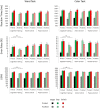A Randomized Controlled ERP Study on the Effects of Multi-Domain Cognitive Training and Task Difficulty on Task Switching Performance in Older Adults
- PMID: 28446870
- PMCID: PMC5388694
- DOI: 10.3389/fnhum.2017.00184
A Randomized Controlled ERP Study on the Effects of Multi-Domain Cognitive Training and Task Difficulty on Task Switching Performance in Older Adults
Abstract
Executive functions are subject to a marked age-related decline, but have been shown to benefit from cognitive training interventions. As of yet, it is, however, still relatively unclear which neural mechanism can mediate training-related performance gains. In the present electrophysiological study, we examined the effects of multi-domain cognitive training on performance in an untrained cue-based task switch paradigm featuring Stroop color words: participants either had to indicate the word meaning of Stroop stimuli (word task) or perform the more difficult task of color naming (color task). One-hundred and three older adults (>65 years old) were randomly assigned to a training group receiving a 4-month multi-domain cognitive training, a passive no-contact control group or an active (social) control group receiving a 4-month relaxation training. For all groups, we recorded performance and EEG measures before and after the intervention. For the cognitive training group, but not for the two control groups, we observed an increase in response accuracy at posttest, irrespective of task and trial type. No training-related effects on reaction times were found. Cognitive training was also associated with an overall increase in N2 amplitude and a decrease of P2 latency on single trials. Training-related performance gains were thus likely mediated by an enhancement of response selection and improved access to relevant stimulus-response mappings. Additionally, cognitive training was associated with an amplitude decrease in the time window of the target-locked P3 at fronto-central electrodes. An increase in the switch positivity during advance task preparation emerged after both cognitive and relaxation training. Training-related behavioral and event-related potential (ERP) effects were not modulated by task difficulty. The data suggest that cognitive training increased slow negative potentials during target processing which enhanced the N2 and reduced a subsequent P3-like component on both switch and non-switch trials and irrespective of task difficulty. Our findings further corroborate the effectiveness of multi-domain cognitive training in older adults and indicate that ERPs can be instrumental in uncovering the neural processes underlying training-related performance gains.
Keywords: N2; P2; P3; Stroop switch task; aging; cognitive training; switch positivity; task difficulty.
Figures



Similar articles
-
Neurophysiological indices of the transfer of cognitive training gains to untrained tasks.Neurobiol Learn Mem. 2020 May;171:107205. doi: 10.1016/j.nlm.2020.107205. Epub 2020 Mar 4. Neurobiol Learn Mem. 2020. PMID: 32145406
-
Effects of multi-domain cognitive training on working memory retrieval in older adults: behavioral and ERP evidence from a Chinese community study.Sci Rep. 2021 Jan 13;11(1):1207. doi: 10.1038/s41598-020-79784-z. Sci Rep. 2021. PMID: 33441734 Free PMC article.
-
Cognitive flexibility and N2/P3 event-related brain potentials.Sci Rep. 2020 Jun 17;10(1):9859. doi: 10.1038/s41598-020-66781-5. Sci Rep. 2020. PMID: 32555267 Free PMC article.
-
Understanding sources of adult age differences in task switching: Evidence from behavioral and ERP studies.Neurosci Biobehav Rev. 2018 Sep;92:255-275. doi: 10.1016/j.neubiorev.2018.05.029. Epub 2018 Jun 6. Neurosci Biobehav Rev. 2018. PMID: 29885425 Review.
-
Effects of Mild Cognitive Impairment on the Event-Related Brain Potential Components Elicited in Executive Control Tasks.Front Psychol. 2018 May 29;9:842. doi: 10.3389/fpsyg.2018.00842. eCollection 2018. Front Psychol. 2018. PMID: 29910756 Free PMC article. Review.
Cited by
-
Training and Transfer of Cue Updating in Older Adults Is Limited: Evidence From Behavioral and Neuronal Data.Front Hum Neurosci. 2020 Dec 4;14:565927. doi: 10.3389/fnhum.2020.565927. eCollection 2020. Front Hum Neurosci. 2020. PMID: 33343316 Free PMC article.
-
Acute Moderate-Intensity Exercise Generally Enhances Attentional Resources Related to Perceptual Processing.Front Psychol. 2019 Nov 8;10:2547. doi: 10.3389/fpsyg.2019.02547. eCollection 2019. Front Psychol. 2019. PMID: 31781010 Free PMC article.
-
ERP and Behavioral Effects of Physical and Cognitive Training on Working Memory in Aging: A Randomized Controlled Study.Neural Plast. 2018 Mar 28;2018:3454835. doi: 10.1155/2018/3454835. eCollection 2018. Neural Plast. 2018. PMID: 29796016 Free PMC article. Clinical Trial.
-
Multidomain Cognitive Training Transfers to Attentional and Executive Functions in Healthy Older Adults.Front Hum Neurosci. 2020 Nov 16;14:586963. doi: 10.3389/fnhum.2020.586963. eCollection 2020. Front Hum Neurosci. 2020. PMID: 33304256 Free PMC article.
-
Anodal Transcranial Direct Current Stimulation-Induced Effects Over the Right Dorsolateral Prefrontal Cortex: Differences in the Task Types of Task Switching.Front Psychol. 2021 Mar 18;12:630239. doi: 10.3389/fpsyg.2021.630239. eCollection 2021. Front Psychol. 2021. PMID: 33815217 Free PMC article.
References
-
- Allport D. A., Styles E. A., Hsieh S. (1994). “Shifting intentional set: exploring the dynamic control of tasks,” in Attention and Performance XV: Conscious and Nonconscious Information Processing, eds Umiltà C., Moscovitch M. (Cambridge, MA: MIT Press; ), 421–452.
LinkOut - more resources
Full Text Sources
Other Literature Sources
Research Materials

